Occupant Comfort and Rammed Earth

Karen Ridgewell ARB, Senior Design Officer, Architecture and Design Scotland shares some insights on the use of Rammed Earth Construction.
Rammed Earth:
In March 2019, A&DS welcomed the Scottish Ecological Design Association (SEDA) for the third annual collaborative event on materials that focused on the use of earth as a construction material. Building with earth is a low carbon emitter compared with other forms of construction that utilise steel, concrete and composite materials. Raw materials can be sourced on-site therefore eliminating reliance on vehicular transportation, which further reduces the embodied energy required to build the structure. As designers and constructors, we will need to understand and reduce the impact of the materials we select and specify. Climate change legislation is moving to focus on the impacts of indirect emissions, which will impact every aspect of our lives. With resource depletion and the negative impacts of global supply chains we wanted to further highlight the process of building with earth, in particular, the use of rammed earth and its potential to positively impact occupant health.
Application:
Rammed earth is an ancient form of construction usually associated with arid areas. Historic examples of its use exist across the globe, with a handful in the UK. Rammed earth is composed of cob, earth, chalk, lime, or gravel which is mixed with clay and aggregates then rammed between temporary formwork walls that are subsequently removed. When dried, the result is a dense solid form subject to less shrinkage than mud walls. These can be designed to be a structural element or a non-load bearing component within a structural frame.
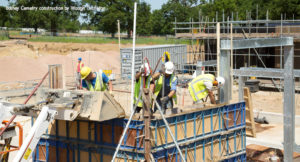
As Scotland’s current climate is generally currently cool and wet, albeit with the east coast having marginally more continental climate than the west, the erection of a rammed earth structure would best be carried out under a temporary roof. Like all other masonry, a rammed earth building will last longer if it is kept dry so it should be cited under a roof that provides decent permanent cover. Alternatively, the walls can be located internally. Walls can be left untouched illuminating the patterns created by the formwork, rendered, painted, or dry lined.
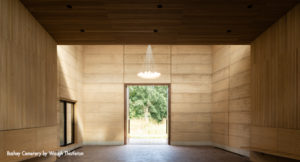
Occupant Comfort:
Rammed earth has been used in a number of high-profile projects across the UK and Europe in recent years, including the Brighton Waste House by BBM, Bushey Cemetery by Waugh Thistleton, the Mass River Observation Tower in the Belgium-Dutch border by De Goulden Liniaal and the Rivergreen Centre by JDDK.
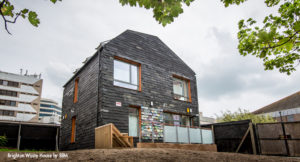
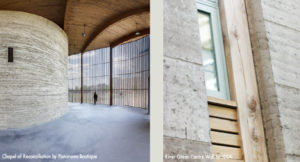
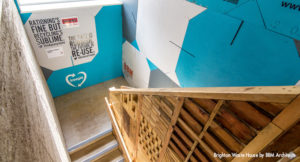
It is however used within a domestic setting for a number of reasons, one of which is occupant comfort. Rammed earth walls, like other masonry structures, have a high thermal mass, containing or absorbing more heat than concrete, even though it is less dense (Soebarto, 2009). External rammed earth walls provide a long thermal time lag, slowing down the heat transfer between the inside and outside. When insulated, rammed earth walls can provide improved internal comfort levels of heat and cold. With benign health qualities, a low carbon footprint, sound absorption and the ability to absorb and release moisture to regulate humidity rammed earth could provide an alternative to current mainstream construction techniques.
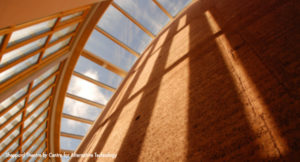
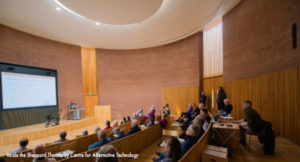
Videos
Rowland Keeble discussing ‘Unstabalised Rammed Earth‘ – Youtube link
Brighton Waste House – a short video highlighting their Rammed Earth Chalk Wall – Vimeo link
Bushey Cemetery, Hertfordshire – RIBA Stirling prize 2018, by Waugh Thistleton – A short film by Jim Stephenson – Youtube link
Training
Earth Building UK (ebuki) has been working with partners in Europe to write training standards or learning outcomes that have converted into National Occupational Standards and National Vocational Qualifications.
- NVQ Unit 549 v2 06-16 Preparing and erecting or conserving and restoring earthen structures in the workplace
- COSVR549 Prepare and Erect or Conserve and Restore Earthen Structures (The UK National Occupational Standard)
For more information visit ebuki: http://ebuki.co/index.htm#sthash.Fbe6yKxR.dpbs
The Centre for Alternative Technology runs a short course and postgraduate courses that focus on natural building materials and construction techniques.
Short Courses
Post Graduate Study
https://www.cat.org.uk/courses-and-training/graduate-school/courses/green-building/
Events
Clayfest: http://ebuki.co/events.htm#sthash.gh0OOARV.dpbs
Resources
Rammed Earth Consulting: http://rammedearthconsulting.com/
Rebearth: http://rebearth.co.uk/
Rammed Earth Structures – A Code of Practice by Julian Keable and Rowland Keable
Available at the RIBA Bookshop: https://www.architecture.com/riba-books/books/sustainability/product/rammed-earth-structures-a-code-of-practice.html
Historic Environment Scotland:
Inform Guide: Earth and Clay Construction https://www.historicenvironment.scot/archives-and-research/publications/publication/?publicationId=e4ed6470-454e-4de1-a978-a59500bbe276
TAN 06 – Earth Structures and Construction in Scotland https://www.historicenvironment.scot/archives-and-research/publications/publication/?publicationId=621c18f3-9a1e-40c6-ba90-a5c300a80a2f
Article Reference
Soebarto, V. (2009), Analysis of Indoor Performance of Houses using Rammed Earth Walls, Eleventh International IBPSA Conference (pp. 27-30)
Image Credits
Brighton Waste House – BBM Architects
Bushey Cemetery Completed – Waugh Thistleton Architects (image credits Jim Stephenson)
Bushey Cemetery Under Construction – Waugh Thistleton Architects (image credits Lewis Kahn)
Chapel of Reconciliation – Panorama Boutique
Rivergreen Centre Wall and Interior – JDDK Architects (image credits Allen Mushen and JDDK Architects)
Sheppard Theatre Wall and Interior – Centre for Alternative Technology











